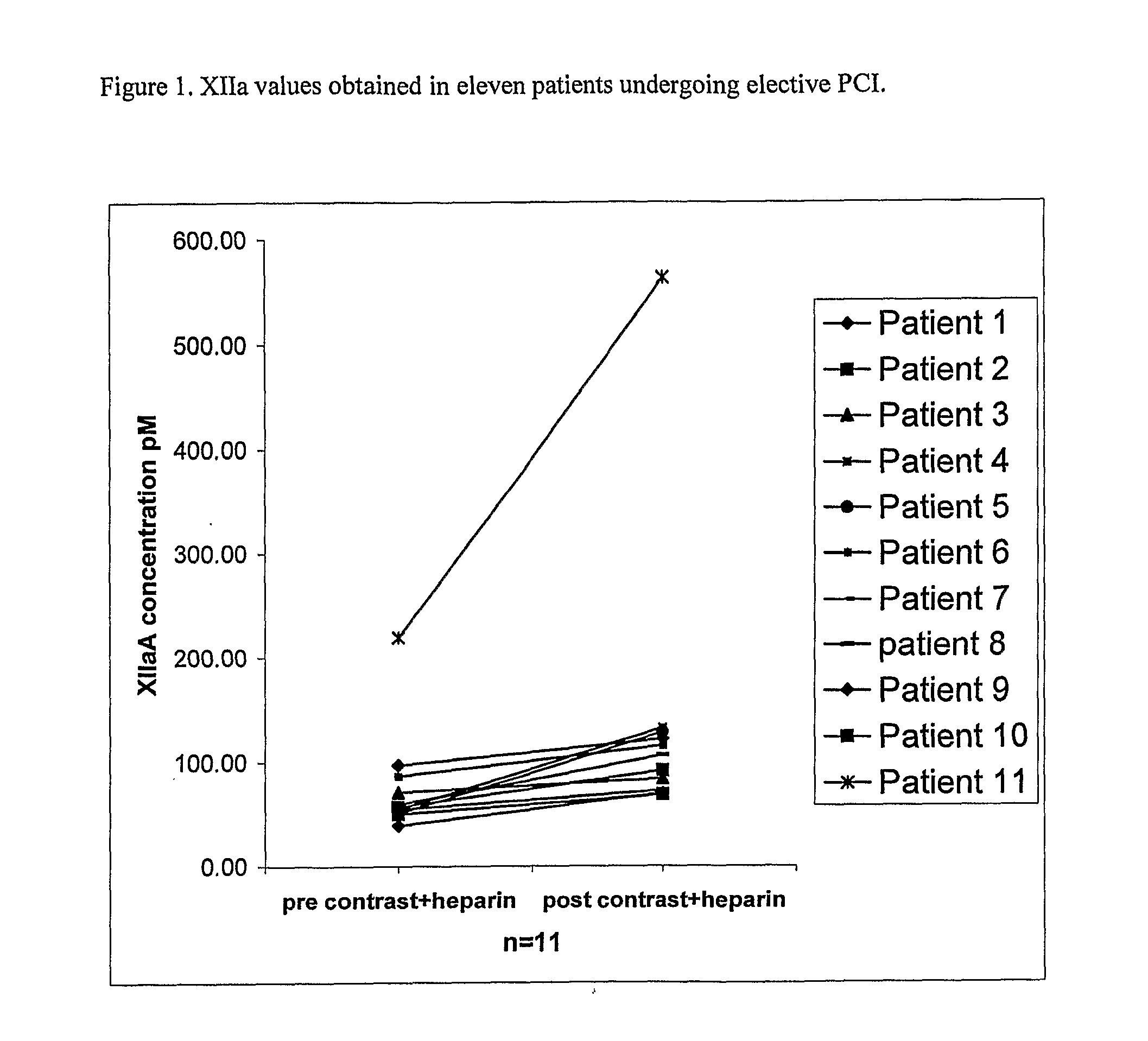Anti-Factor Xlla Therapy
a technology of anti-factors and xlla, which is applied in the field of anti-factor xlla therapy, can solve the problems of affecting the function of the immune system, and affecting the function of the immune system, and achieves the effect of preventing arterial thrombosis
- Summary
- Abstract
- Description
- Claims
- Application Information
AI Technical Summary
Benefits of technology
Problems solved by technology
Method used
Image
Examples
example 1
XIIa in Restenosis Following Percutaneous Transluminal Coronary Angioplasty
[0104]Percutaneous coronary intervention (PCI) encompasses a variety of procedures used to treat patients with diseased arteries of the heart, for example, chest pain caused by a build-up of fats, cholesterol, and other substances from the blood (referred to as plaque) that can reduce blood flow to a near trickle, or a heart attack caused by a large blood clot that completely blocks the artery.
[0105]Typically, PCI is performed by threading a slender balloon-tipped tube—a catheter—from an artery in the groin to a trouble spot in an artery of the heart (this is referred to as percutaneous transluminal coronary angioplasty—also known as PTCA, coronary artery balloon dilation or balloon angioplasty). The balloon is then inflated, compressing the plaque and dilating the narrowed coronary artery so that blood can flow more easily. This is often accompanied by inserting an expandable metal stent. Stents are wire mes...
example 2
[0114]This example demonstrates that elevated levels of Factor XIIa provides are associated with increased risk of all cause mortality in patients admitted to hospital with suspected myocardial infarction and acute coronary syndrome.
[0115]Data was obtained on 871 patients admitted to the hospital. Each patient had Factor XIIa measured. Data from these assays were studied to ascertain if it provided prediction of the primary clinical endpoints of all cause mortality.
[0116]The prognostic utility of the assays was determined by ranking the Factor XIIa values (from lowest to highest) and then splitting the population into quartiles i.e. the 25% of individuals with the lowest Factor XIIa concentrations were in the 1st quartile, whilst the 25% of individuals with the highest concentrations were in the 4th quartile.
[0117]The form of XIIa was measured using high performance liquid chromatography following reaction of the sample with Iodine 125 labelled antibody.
[0118]Fab antibody fragments ...
example 3
[0124]This example demonstrates that changes in concentration of Factor XIIa provides are associated with risk of secondary myocardial infarction in patients admitted to hospital with myocardial infarction.
[0125]Data was obtained on 315 patients admitted to the hospital. Blood samples were obtained at admission and 4 days after admission. Each patient had Factor XIIa measured. Data from these assays were studied to ascertain if changes in the concentration of Factor XIIa provided prediction of the primary clinical endpoints of a second myocardial infarction within 30 days of admission. At 30 days follow-up, 24 patients had suffered a secondary myocardial infarction.
[0126]XIIa was measured using high performance liquid chromatography following reaction of the sample with Iodine 125 labelled antibody.
[0127]Fab antibody fragments of antibody 2 / 215 were prepared using an “Immunopure Fab Preparation Kit” Pierce, 3747 N Meridian Road, PO Box 117, Rockford, Ill. 61105, U.S.A.) according to...
PUM
| Property | Measurement | Unit |
|---|---|---|
| concentration | aaaaa | aaaaa |
| concentration | aaaaa | aaaaa |
| volume | aaaaa | aaaaa |
Abstract
Description
Claims
Application Information
 Login to View More
Login to View More - R&D
- Intellectual Property
- Life Sciences
- Materials
- Tech Scout
- Unparalleled Data Quality
- Higher Quality Content
- 60% Fewer Hallucinations
Browse by: Latest US Patents, China's latest patents, Technical Efficacy Thesaurus, Application Domain, Technology Topic, Popular Technical Reports.
© 2025 PatSnap. All rights reserved.Legal|Privacy policy|Modern Slavery Act Transparency Statement|Sitemap|About US| Contact US: help@patsnap.com



